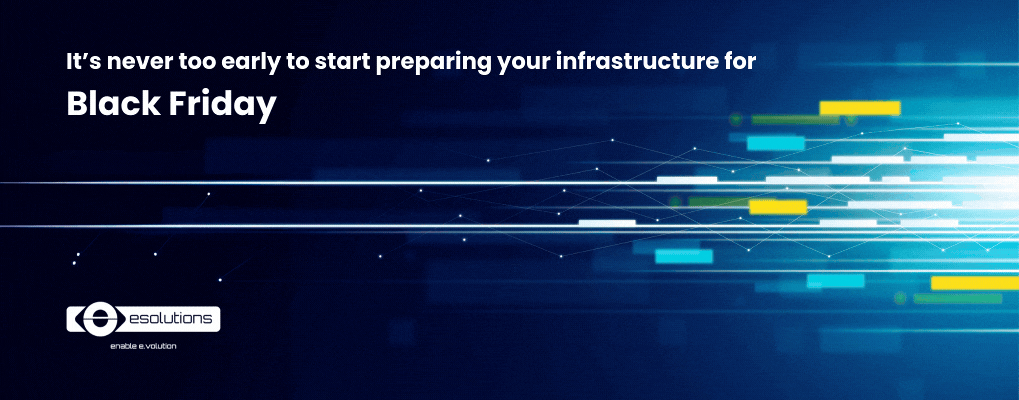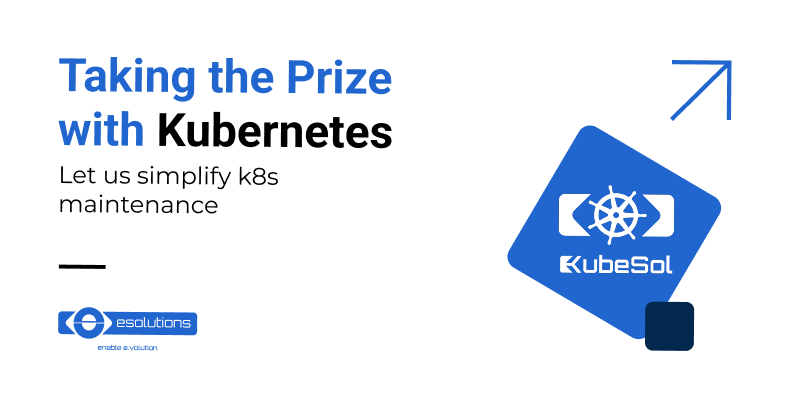
There’s no doubt that Black Friday represents the height of the year in e-commerce in Romania. Infrastructure plays an important role for online retail companies on Black Friday, but not only. Retailers run campaigns throughout the year - think about Valentine’s Day, Women’s Day, Easter, Children’s Day, Back to School, Halloween, Cyber Monday, Christmas, and any other seasonal or business-specific campaigns. Your own e-commerce business can run into scalability or high availability troubles at times, so having a reliable infrastructure should be top of mind.
What changes have we noticed in customer behaviour when it comes to online shopping? Can your systems or applications withstand the increased traffic load? What does Black Friday teach us in terms of infrastructure? Why do online retailers turn to Kubernetes? And which are the fastest and the longer-term options for a great technical stack for online retailers? There's a lot of questions to be answered. Read below to find out more about the business aspects, as well as the technical ones, in having the proper infrastructure for your sales campaigns.

Historically, Black Friday was regarded as the time to buy large appliances at discounted prices, with Romanian customers focusing more on home appliances and IT gadgets.
However, recent trends show a shift to smaller items and even consumables in the past couple of years.
According to articles by ArenaIT and Mobillisimo, the top products ordered on eMAG this year were:
That's quite a surprise, isn't it?
More edible and cosmetic products, toys, and cleaning supplies, than laptops, TVs, or kitchen appliances. There are multiple reasons why Romanians buy fewer gadgets or appliances on Black Friday, but we are not here to discuss those.
The big change that we noticed and would like to discuss, however, is that Romanians are starting to buy more consumables online, rather than from physical stores. This means any shop, pharmacy, bookstore, cosmetics shop, clothing store, and so on, must be prepared to scale their website to support this trend and remain relevant on the market.
On an additional note, the smart parcel lockers have been springing up all throughout Romania, a market that has grown massively since the start of the pandemic. Why is this important? Customer behaviour has changed not only in what people order, as we have already seen, but in how they order also. Smart lockers make it easy to order anything you need online.
Let’s take a look at some of last year’s Black Friday stats from Ziarul Financiar. For instance, by 5:30 PM on Romania’s Black Friday (8 November 2024) PayU GPO Romania, one of the popular online payment service providers in Romania, reported the following statistics from the Media Center:
The numbers of transactions directly influences the spikes in infrastructure that can appear during an online retail sales campaign.
A more detailed view of last year’s Black Friday in Romania you can find on ecompedia, where a couple of main online shops, such as: eMAG.ro, MerchantPro, bookzone.ro, trendyol.com, springfarma.com, Gomag, and evomag.ro were analyzed.
Of course, more transactions means business growth.
But business growth is only useful if your infrastructure can handle it, and…
Building a great infrastructure is not a task that can be accomplished overnight; moreover, it’s best when it is built with a long-term vision in mind, as it requires careful planning, strategic investment, and a deep understanding of the needs of the organization as well as the demands of the environment. Comprehensive planning, design and architecture, implementation and development, testing and optimization, and continuous improvement, are some of the key aspects in building a successful infrastructure.
If Black Friday 2025 seems like it’s too far for you to focus on, keep in mind:
And having a reliable infrastructure can support any other campaign you may wish to run - from Valentine’s and Women’s Day, to Easter, Back to School, Halloween, Christmas, and so on.

If we take into consideration that even large online retailers encounter website or app issues during high traffic, mid-sized retailers should not feel bad. It can happen to everyone. However, while major retailers usually have an in-house dedicated team to monitor and solve existing issues, mid-sized retailers might not have this aspect covered yet; in this case, a good overview of your existing infrastructure can go a long way for future campaigns.
If you’re not sure whether your infrastructure is up for the job (pun intended), a first step you might want to consider is performing an audit. A proper and objective IT overview audit can bring light to your apps and overall IT system, help you find operational bottlenecks, or evaluate quality attributes such as scalability and maintainability.
Let’s take, for instance, the example of monolithic architectures. A monolithic architecture, which we often refer to as a legacy system, is one of the main reasons for which scalability is almost impossible to achieve. While monolithic systems probably did their job well in the past, the current needs and trends for increased scalability turn them obsolete and might represent the reason why your website or app is down during high-traffic periods. While this represents a major bottleneck, there are other issues that an audit can help you uncover. You can also check out more details here.
Kubernetes is very popular nowadays and it's well established infrastructure solution in the market. Although it shouldn’t be the go-to for all types of projects, in the e-commerce use case it is particularly appropriate, due to the need of a stable but scalable infrastructure. Kubernetes' auto-scaling features, combined with the ability to over-provision resources, can help ensure that your application infrastructure has the necessary capacity to handle even the most significant spikes on Black Friday or any other campaign.
At the implementation and maintenance level, Kubernetes brings a couple of benefits both for DevOps, and for developers.
Kubernetes adoption is fast for DevOps and facilitates the automation of deployment, scaling, and management of containerized applications. This streamlining allows your teams to focus on delivering features rather than managing infrastructure, leading to faster release cycles.
Kubernetes also supports IaC principles, enabling teams to define their infrastructure in code. This approach not only enhances consistency and repeatability but also simplifies the onboarding process for new team members, as they can quickly understand the infrastructure setup through code.
Kubernetes services are inherently scalable, with auto-scaling capabilities that can be implemented as long as resources are available. But you can also simply scale up or down, based on demand, ensuring that resources are used efficiently.
K8s is also particularly well-suited for microservices, allowing for platform scaling in response to demand, such as during high-traffic periods with numerous requests for catalog browsing, checkout processes, or others, ensuring a smooth checkout experience even during peak times like Black Friday.
When it comes to maintenance, Kubernetes has self-healing capabilities, automatically monitoring the health of the application, and can restart or replace containers that fail, leading to lower downtime.
For development teams, Kubernetes allows for fast prototyping and rapid development cycles. Kubernetes integrates seamlessly with Continuous Integration and Continuous Deployment (CI/CD) tools, enabling automated testing and deployment. By adopting Kubernetes, organizations can standardize their deployment processes and infrastructure, reducing inconsistencies and technical debt.
It also supports A/B testing, which can be conducted across different regions, utilizing alternative carts or features to gather marketing and customer insights. Another useful feature is canary deployment, a method of implementing A/B testing where a new feature is tested by directing only a small percentage of traffic to the new service version. This allows for monitoring and verification of performance before gradually increasing the traffic to the new service, until the migration process is complete.
Kubernetes is designed with cloud-native principles in mind, making it compatible with modern standards and ensuring that organizations can leverage the latest technologies and practices be it in the cloud, or on-premise.
We’ve seen that Kubernetes now represents a standard in the industry, with standard protocols and parameters for application deployment. However, to correctly deploy and manage a Kubernetes cluster, you need to know a lot of things, such as DNS, networking, storage, security, and so on.
While starting a Kubernetes cluster is not difficult, knowing the fundamentals for maintaining it the right way has a learning curve. While it can automate a lot of things, the staff managing it still needs to understand those things to begin with. That is why the number one reason for not adopting Kubernetes is no in-house skilled staff.
This is where KubeSol comes in. Our tool provides an easy installer for your team to start working on Kubernetes quicker. It also features standard tools for DevOps, and easy administration, upgrades, and maintenance. Since KubeSol was built by DevOps engineers for DevOps engineers, you can expect all actions to be DevOps-oriented.
If you’re looking to upskill your in-house team, KubeSol can help with easy Kubernetes installation and administration.
Events like Black Friday or other sales campaigns can be either a dream come true, or a real-life nightmare for your business. Making sure your infrastructure is prepared for the high workloads is one of the most important aspects that you should focus on, and that’s where IT audits come in.
In case you plan on running a specific high-traffic online retail campaign or are already set on modernizing your IT infrastructure for the next Black Friday, our DevOps team is ready to help audit your systems and provide seamless business operations.

An enthusiastic writing and communication specialist, Andreea Jakab is keen on technology and enjoys writing about cloud platforms, big data, infrastructure, gaming, and more. In her role as Social Media & Content Strategist at eSolutions, she focuses on creating content and developing marketing strategies for the eSolutions blog and social media platforms.
 Bogdan Stoean, Head of Technology Consulting at eSolutions, enjoys tackling challenging problems related to scalability, performance, and cloud migrations for organizations in various industries. With almost 14 years of experience as a software engineer, technical lead, software architect, and consultant, he understands where technology and business strategy intersect and provides the appropriate technical solutions for our partners.
Bogdan Stoean, Head of Technology Consulting at eSolutions, enjoys tackling challenging problems related to scalability, performance, and cloud migrations for organizations in various industries. With almost 14 years of experience as a software engineer, technical lead, software architect, and consultant, he understands where technology and business strategy intersect and provides the appropriate technical solutions for our partners.